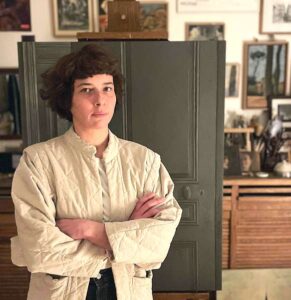Chiara Gaggiotti graduated in Architecture from the “La Sapienza” University of Rome. In the year 2015 she left her work as an Architect to devote herself entirely to painting. Chiara had been teaching observation drawing for ten years at the National Higher School of Architecture in Paris – Belleville.

“Art, whatever it takes” – RomeArtProgram has made interviews with people involved in art, living in Italy, the USA and the UK, to know their feelings during the emergency.
-Interview with Chiara Gaggiotti:
RomeArtProgram: What is your definition of “art” today?
–Chiara: I would say that it is the concrete manifestation of the spirit, a subjective expression indissociable from knowing “how to do”. Art uses forms and their interaction to translate the vision of an optical impression into an intimate vision of the things that surround us.
RAP: Art is dynamic and regenerates itself… how does it change, and how did it change us?
–Chiara: Art changes with man and his history, it seems to me to be one of the keys to understanding human nature. What then changes in each of us remains a personal matter, in my opinion.
RAP: When (and how) did you understand that art was becoming very important in your life?
–Chiara: When I decided to leave my job as an architect to devote myself exclusively to painting and teaching drawing.
RAP: What role does art play today? What are the “great figures” who have recently changed it? Do you feel close to any of these figures?
–Chiara: I believe there is confusion today. A great diffusion of works without depth or humility, labeled as works of art, create misunderstanding about what is of the order of the idea -more or less funny- and what is proper to the work of art. Artists such as Balthus, Freud, Music, Szafran, Lopez Garcia, Morandi, in the twentieth century, clearly show all that a work of art is capable of transmitting.
RAP: Are there still traditional figures such as collectors, muses, mecenate and patrons, in today’s art and society interaction model?
–Chiara: Of course, exactly as in the past. What is often observed today, however, is that the artist must be a name before being a work, this deflects the role and interest of traditional figures, creates a mythical distorted vision of the artist, not to mention the catastrophic effects on his work.
RAP: How have the new technologies and media culture changed art today, improving or worsening it…? What do you feel are your biggest challenges?
–Chiara: I don’t think that the new technologies can improve or worsen art. It is a tool like any other; it depends on the quality of the work. In no case the new technologies should be decisive.
RAP: Art as a mirror of man, in this moment of emergency seems to be shattered …what do these fragments reflect now?… Shadow or light of the moment?
–Chiara: Definitely both.
RAP: Understanding, interpreting, and then possibly judging the work of art; which is the right path when we are in front of a piece of art?
–Chiara: There are no right phases, just as there is no objective process neither to understand nor to interpret. When you are naturally attracted or fascinated by a work, the only explanation is to be found within yourself. The rules of objective beauty, that guided us in the past, are no longer of our time, but the laws of human nature remain and this needs mimésis. We need to recognize ourselves in a work, this is what makes us love it.
RAP: Which is the real role of Academies and Art schools today? What can artists learn from these institutions today?
–Chiara: I teach in an architecture school where drawing and painting luckily still play a role in the training of future architects. What I try to convey through drawing is an autonomy of thought, the ability to question oneself by observing through the manipulation of basic tools. I believe that the empirical and intellectual approaches are inseparable.
RAP: Art too has undergone a complex process of globalization; can having an authentic and genuine style be an advantage or a drag for an artist?
–Chiara: I don’t see how it’s possible to be at a disadvantage, when one is authentic, unless one has nothing to say. I believe that globalization in art makes no sense, or rather as the art historian Duccio Budassi would say “I consider globalization the worst possible evil”.
RAP: How do Art Galleries and Museums position themselves today, and, in your opinion, how should they?
–Chiara: Some galleries and museums, unfortunately unfortunately not most of them, still defend what they love. For the rest, globalization dictates the law with all the sterile consequences of the case.
RAP: “Figuration” vs “Abstraction” ? Which of the two is better descriptive of the period we live in? Which one will have a better future?
–Chiara: I wouldn’t make it a question of style. For me there only are good and bad paintings.
RAP: Today we often speak of “emerging artists”; what advice based on your experience do you feel you can give to young artists?
–Chiara: Protecting one’s freedom… this is one of the wonderful aspects of this job.
RAP: Art as a lens for reading the present, can it modify the space and time we pass through? …will art save us?
–Chiara: I would rather ask myself how to save art.
www.chiaragaggiotti.com
______________________
RomeArtProgram
#romeartprogram
Art-as-Power
.
